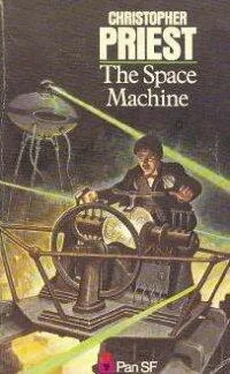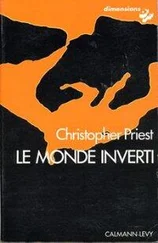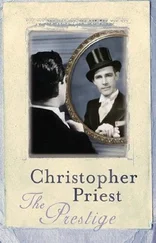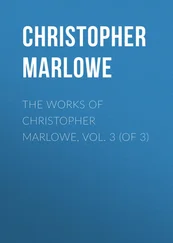One such was a device used by the Martians in conjunction with their watch-towers.
Directly outside the dormitory building we settled in, and visible to us from our hammocks, was one of the watch-towers. After we had been in occupation for about eight days, Amelia pointed out that there appeared to be something wrong with it, for its observation platform had ceased to rotate to and fro. That night we saw that its light was not on.
The very next day one of the vehicles came to a halt beside the tower, and there took place a repair operation I can only describe as fantastic.
The vehicle in question was of a type we had occasionally seen about the city: a long, low machine which, above its drive-leg platform, was an apparent mass of glittering tubing, heaped in disorder. As the legged vehicle halted beside the watch-tower, this confusion of metal reared itself up, to reveal that it possessed five of the peristaltic legs, the remainder of the appendages being a score or more of tentacular arms.
It stepped down from the platform of the vehicle, the jointed arms clanging and ringing, then walked the short distance to the base of the tower with a movement remarkably like that of a spider. We both looked, for some clue as to how the thing was being driven, but it seemed that either the monstrous machine had an intelligence of its own, or else it was controlled in some incredible way by the driver of the vehicle, for there was plainly no one anywhere near it. As it reached the base of the tower, one of its tentacles was brought into contact with a raised metal plate on one of the pillars, and in a moment we saw that the observation platform was lowering. Apparently it could lower itself only so far, for when the platform was about twenty feet from the ground the tentacular device seized the tower’s legs in its horrid embrace, and began to climb slowly upwards, like a spider climbing a strand of its web.
When it reached the observation-platform it settled itself in position by clinging on with its legs, and then with several tentacles reached through a number of tiny ports, apparently searching for the parts of the mechanism which had failed.
Amelia and I watched the whole operation, unnoticed inside the building. From the arrival of the legged vehicle to its eventual departure, only twelve minutes elapsed, and by the time the iron monster had returned to its place on the rear of the vehicle, the observation-platform had been raised to its erstwhile height, and was rotating to and fro in its usual way.
So far, I have not had much to say about our day-to-day survival in this desolate city, nor, for the moment, will I. Our internal preoccupations were many and great, and, in several ways,more important than what we were seeing about us. Before turning to this, though, I must first establish the context. We are all creatures of our environment, and in disturbingly subtle ways Amelia and I were becoming a little Martian in our outlook. The desolation about us was reaching our souls.
As we moved about the city one question remained ever unanswered. That is to say: how did the ordinary Martian occupy his time?
We now understood something of the social ramifications of Mars. This was in effect that the lowest social stratum was the slave-people, who were forced to do all the manual and demeaning tasks necessary to any civilized society. Then came the Martians of the city, who had powers of supervision over the slaves. Above these were the men who drove the legged vehicles and, presumably, operated the other mechanical devices we saw.
It was the city-dwelling Martians in whom we were most interested, for it was among them that we lived. However, not all of these were occupied. For instance, it took relatively few of them to supervise the slaves (we often saw just one or two men able to control several hundred slaves, armed with only the electrical whips), and although the vehicles were many in number, there were always plenty of people in the city, apparently idle.
On our perambulations Amelia and I saw much evidence that time hung heavy on these people. The nightly carousing was obviously a result of two factors: partly a way of appeasing the endless grief, and partly a way of expressing boredom. We frequently saw people squabbling, and there were several fights, although these were dissipated instantly at the sight of one of the vehicles. Many of the women appeared to be pregnant; another indication that there was not much to occupy either the minds or the energies of the people. At the height of the day, when the sun was overhead (we had come to the conclusion that the city must be built almost exactly on the Martian equator), the pavements of the streets were littered with the bodies of men and women relaxing in the warmth.
One possibility that would account for the apparent idleness was that some of them were employed in the near-by industrial area, and that the Martians we saw about the city were enjoying some leave.
As we were both curious to see the industrial areas and discover, if we could, what was the nature of all the furious activity that took place, one day, about fifteen days after our arrival, Amelia and I determined to leave the city and explore the smaller of the two complexes. We had already observed that a road ran to it, and that although the majority of the traffic was the haulage type of vehicle, several people—both city-dweller and slave—were to be seen walking along it. We decided, therefore, that we would not attract unwanted attention by going there ourselves.
We left the city by a system of pressurized corridors, and emerged into the open. At once our lungs were labouring in the sparse atmosphere, and we both remarked on the extreme climate: the thin coldness of the air and the harsh radiance of the sun.
We walked slowly, knowing from experience how exercise debilitated us in this climate, and so after half an hour we had not covered much more than about a quarter of the distance to the industrial site. Already, though, we could smell something of the smoke and fumes released from the factories although none of the clangour we associated with such works was audible.
During a pause for rest, Amelia laid her hand on my arm and pointed towards the south.
“What is that, Edward?” she said.
I looked in the direction she had indicated.
We had been walking almost due south-east towards the industrial site, parallel to the canal, but on the far side of the water, well away from the factories, was what appeared at first sight to be an immense pipeline. It did not, however, appear to be connected to anything, and indeed we could see an open end to it.
The continuation of the pipe was invisible to us, lying as it did beyond the industrial buildings. Such an apparatus would not normally have attracted our attention, but what was remarkable was the fact of the intense activity around the open end. The pipe lay perhaps two miles from where we stood, but in the clear air we could see distinctly that hundreds of workers were swarming about the place.
We had agreed to rest for fifteen minutes, so unaccustomed were we to the thin air, and as we moved on afterwards we could not help but glance frequently in that direction.
“Could it be some kind of irrigation duct?” I said after a while, having noticed that the pipe ran from east to west between the two diverging canals.
“With, a bore of that diameter?”
I had to admit that this explanation was unlikely, because we could see how the pipe dwarfed those men nearest to it. A reasonable estimate of the internal diameter of the pipe would be about twenty feet, and in addition the metal of the tube was some eight or nine feet thick.
We agreed to take a closer look at the strange construction, and so left the road, striking due south across the broken rock and sand of the desert. There were no bridges across the canal here, so the bank was as far as we could proceed, but it was close enough to allow us an uninterrupted view.
Читать дальше











